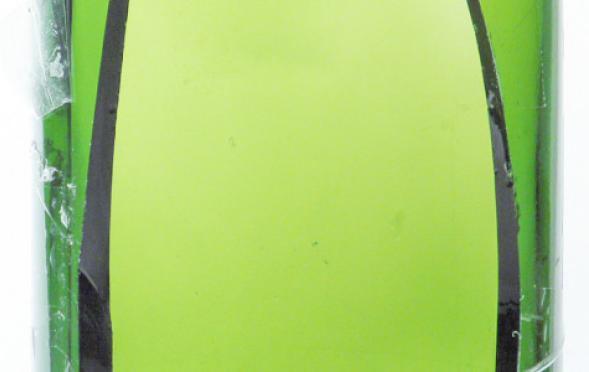Defect of the Month
Back to AGR's Library
Stones and cord in glass can sometimes go hand-in-hand. This container has a large refractory stone in the heel that also created a highly stressed cord in the sidewall. Although a polarimeter cannot reliably detect cord when the bottle is viewed through the sidewall, high magnitude cord stress can sometimes be seen in this manner. The small knots of stress within the cord are additional particles of the stone created as it dissolved within the melt.

A triangle of magenta, a slash of yellow, and a gentle gradient of blue would fit right into an exhibit of minimalistic abstract artwork. But the scientific content of this image is anything but minimal. Ring sections of glass are routinely examined for cord stresses using polarized light microscopy per ASTM C978. This particular ring section shows a strong tension cord on the exterior surface of the container, which appears bright yellow in this orientation. The magenta triangle is the background color, and the blue gradient is compression induced in the glass by the cord. High magnitude tensile stress on the exterior surface is a concern for containers, especially those that contain a carbonated product. Breakage in the pasteurizer or delayed breakage in the warehouse are the most common problems due to cord.

This typical lehr crack consists of fracturing in the bottom and sidewall sections of a wine bottle that was extended in the annealing lehr. Lehr cracks typically originate at moderately severe (or worse) flaws created upstream of the lehr. Most commonly, the flaw or damage is located on the bearing surface which then extends into a fracture due to the thermal stresses produced during the annealing process. A common feature of lehr cracks is a series of dwell marks on the fracture surface indicating that the fracture extended to a certain point and then paused before being acted upon again and extending further. Thick bottomed items such as sparkling wine bottles are more susceptible to lehr crack formation. Darker glass and thick bottoms can also lessen the likelihood that lehr cracks are identified through inspection. Lehr cracks are strength-reducing defects and may fracture the container immediately upon handling.

If you’ve ever visited Chicago, it’s likely that you’ve seen it’s iconic, shiny “Bean” sculpture. Officially titled “Cloud Gate,” the smooth surface reflects the surrounding cityscape as well as the sky above. From a physics perspective, reflections occur when light encounters an interface between two materials with different refractive indices. The flaw in the photomicrograph causes a reflection due to the smooth interface air encapsulated within the glass. This type of flaw is an inclusion referred to as a seed or a blister, depending on its relative size. Seeds and blisters have a number of possible causes, ranging from problems with refining during glass melting to air that is entrapped during container formation.
Pagination
- Previous page
- Page 4
- Next page